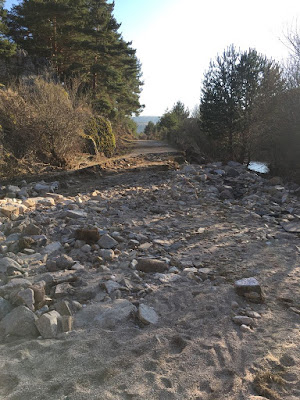Os dejamos algunas fotos que muestran los efectos de la avenida ocurrida en el arroyo Chubieco, en el término municipal de Peguerinos (Ávila). Coordenadas: 40º 38'2.16'' N, 4º 13' 17.98 W. Las fotos son de María del Monte Maíz, y fueron tomadas el 19 de febrero de 2017. La riada aconteció en la noche del 16 de febrero.
jueves, 31 de agosto de 2017
martes, 29 de agosto de 2017
Final analysis of the accuracy and precision of methods to calculate the sediment retained by check dams
Nuestra última publicación:
Ramos-Diez, I., Navarro-Hevia, J, San Martín, R., Mongil-Manso, J., 2017. Final analysis of the accuracy and precision of methods to calculate the sediment retained by check dams. Land Degradation and Development. DOI: 10.1002/ldr.2778
ABSTRACT
Knowing how much sediment check dams have trapped during their lifespan is essential to estimate their effectiveness or the sediment yields of their basins. Methods to calculate the volume of sediment trapped by check dams play an important role in the understanding of these issues. Several authors have proposed different methods to measure the volume of retained sediment, but their accuracy has, as yet, not been precisely determined and is currently a subject of debate.
We compare the most frequently used methods (geometric: Prism, Pyramid and Geometric; topographic: DTMs, Trapezoids and Sections methods) to evaluate their accuracy and precision in determining the volume of sediment retained by check dams. Our calculations are based on ten virtual check dams simulated in several gullies of Saldaña (Spain), where we determine their volumetric capacity for trapping sediment (RV). This was made by means of an intensive topographic survey of these gullies, employing a terrestrial laser scanning system to obtain a high resolution digital elevation model (5x5 cm, ±2 mm).
The results showed that topographic methods provided a very good fit to RV with a difference of around 8%, being the Sections method the most accurate. Geometric methods were less accurate, showing differences of up to 28%. Thus the results obtained until now by geometric methods should be considered with caution. Although topographic methods were more accurate, they require many field data and much time than the others. So, geometric methods can still be useful by correcting their results using our obtained percentage of variation. Knowing the accuracy of the methods before measuring is essential to obtain the most reliable results to analyse the role of check dams in controlling sediment, erosion processes and land degradation.
Enlace revista
Ramos-Diez, I., Navarro-Hevia, J, San Martín, R., Mongil-Manso, J., 2017. Final analysis of the accuracy and precision of methods to calculate the sediment retained by check dams. Land Degradation and Development. DOI: 10.1002/ldr.2778
ABSTRACT
Knowing how much sediment check dams have trapped during their lifespan is essential to estimate their effectiveness or the sediment yields of their basins. Methods to calculate the volume of sediment trapped by check dams play an important role in the understanding of these issues. Several authors have proposed different methods to measure the volume of retained sediment, but their accuracy has, as yet, not been precisely determined and is currently a subject of debate.
We compare the most frequently used methods (geometric: Prism, Pyramid and Geometric; topographic: DTMs, Trapezoids and Sections methods) to evaluate their accuracy and precision in determining the volume of sediment retained by check dams. Our calculations are based on ten virtual check dams simulated in several gullies of Saldaña (Spain), where we determine their volumetric capacity for trapping sediment (RV). This was made by means of an intensive topographic survey of these gullies, employing a terrestrial laser scanning system to obtain a high resolution digital elevation model (5x5 cm, ±2 mm).
The results showed that topographic methods provided a very good fit to RV with a difference of around 8%, being the Sections method the most accurate. Geometric methods were less accurate, showing differences of up to 28%. Thus the results obtained until now by geometric methods should be considered with caution. Although topographic methods were more accurate, they require many field data and much time than the others. So, geometric methods can still be useful by correcting their results using our obtained percentage of variation. Knowing the accuracy of the methods before measuring is essential to obtain the most reliable results to analyse the role of check dams in controlling sediment, erosion processes and land degradation.
Enlace revista
Suscribirse a:
Comentarios (Atom)









